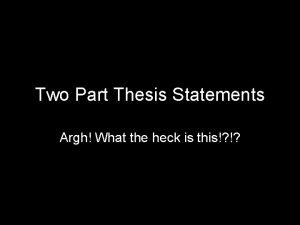Persuasive Techniques in Edwards Sinners in the hands









- Slides: 9

Persuasive Techniques in Edward’s “Sinners in the hands of an angry god” An Intro to Rhetorical Techniques

Breaking Down the Sermon: SOAPSTone Before we begin analyzing rhetorical devices, lets first break down the sermon itself using the SOAPSTone method. Answer the following questions for Edward’s sermon “Sinners in the Hands of an Angry God”: Who is the Speaker? What is the Occasion? (Think time/place/context of the sermon) Who is the intended Audience? What is the Purpose? (What does Edwards want the audience to think/do? ) What is the Subject? (Keep this to a few key words/phrases) What is the TONE? (The author’s attitude towards his subject? )

Breaking Down the Sermon: SOAPSTone Speaker: Jonathan Edwards, Puritan Minister Occasion: 1741, Massachusetts; part of the “Great Awakening”, so it is written in response to increasing secularism in an attempt to bring people back to the church. Audience: Puritan congregation; “unconverted” parishioners Purpose: To convince his congregation of their sinful nature and the need to undergo a “public conversion” to save themselves from God’s wrath; to increase the power of the church

Breaking Down the Sermon: SOAPSTone Subject: The constancy and uncertainty of God’s wrath on those “unconverted men” of the congregation and the imperative need to undergo a “public conversion” according to Puritan belief. TONE: Fiery, angry, enraged, urgent

Rhetorical Appeals Aristotle divided rhetorical appeals into three main categories: 1. Ethos: Ethical appeals. Attempts to persuade by establishing the speaker as credible and trustworthy. 2. Pathos: Emotional appeals. Attempts to persuade by appealing to the emotions, both positive and negative. 3. Logos: Logical appeals. Attempts to persuade by using facts, claims, and statistics.

Ways to Develop/Strengthen a Persuasive Argument Use repetition of words/phrases/images Use figurative language, such as metaphors and similes to make comparisons and connections Use vivid imagery to paint a lasting picture in the audience’s mind Use loaded language, or language/words that seeks to influence by appealing to ones emotions or playing off stereotypes.

Examples of Rhetorical Appeals A commercial selling toothpaste claims to be 98% effective at eliminating the bacteria that causes cavities. This same commercial has a “real dentist, not a paid actor” touting its benefits and telling the audience he always recommends this particular brand to his patients. Logical appeal-use of statistics (98% effective) Ethical appeal-a “real dentist”, who is presumably an expert.

Examples of Rhetorical Appeals The ASPCA commercial with all the sad, sick looking puppies and kittens in cages, looking at the camera with sad eyes, while that super-sad song plays in the background. Emotional appeal-it makes you feel sad, and guilty, so you donate money.

Examples of Rhetorical Appeals A car company uses words like “patriotic”, “American”, “tough”, and “rugged” to describe the truck they are selling. Loaded language-uses emotionally charged words with positive connotations
 Sinners in the hands of an angry god persuasive techniques
Sinners in the hands of an angry god persuasive techniques Hand on hip
Hand on hip Tactile imagery
Tactile imagery Korematsu vs us apush definition
Korematsu vs us apush definition Repetition in sinners in the hands of an angry god
Repetition in sinners in the hands of an angry god Two part thesis
Two part thesis Sinners in the hands of an angry god summary
Sinners in the hands of an angry god summary Sinners in the hands of an angry god video
Sinners in the hands of an angry god video First great awakening apush
First great awakening apush If god should only withdraw his hand from the floodgate
If god should only withdraw his hand from the floodgate
















